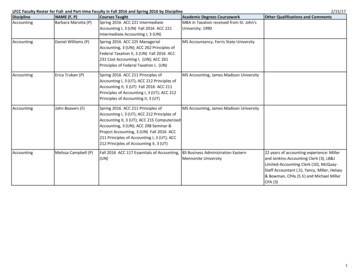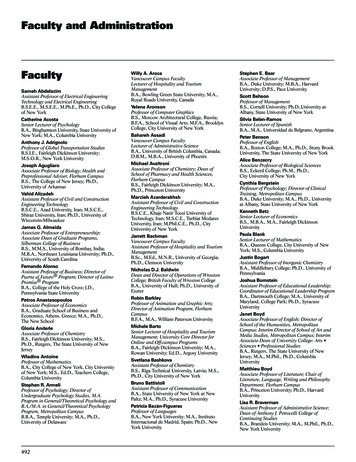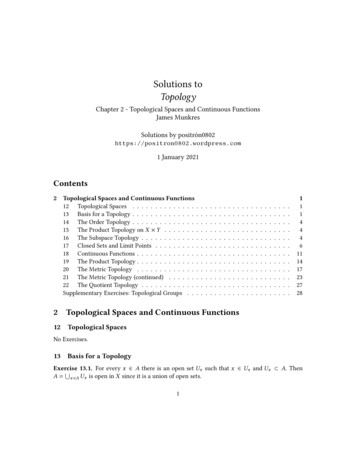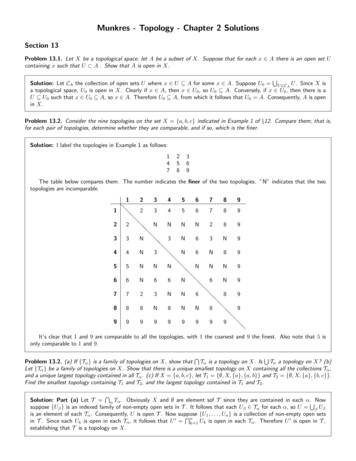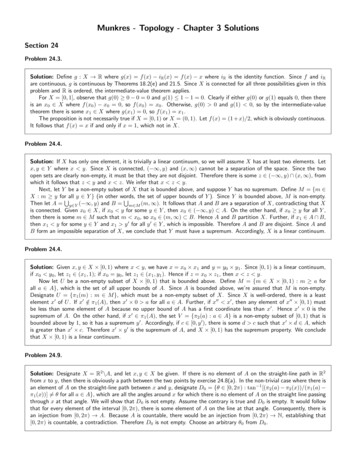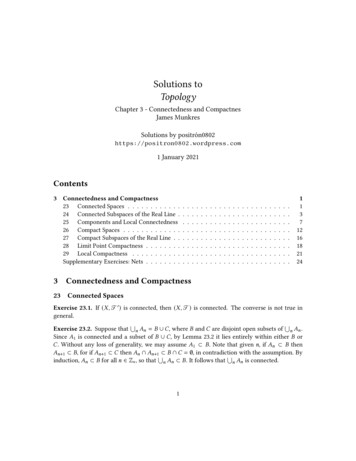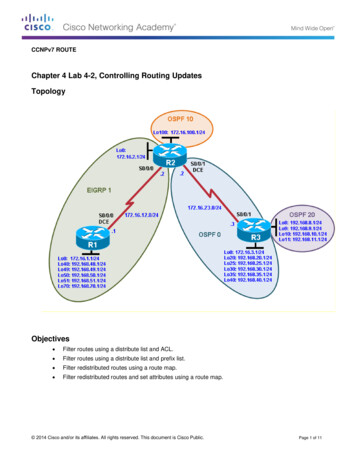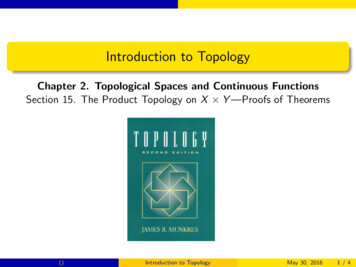
Transcription
Introduction to TopologyChapter 2. Topological Spaces and Continuous FunctionsSection 15. The Product Topology on X Y —Proofs of TheoremsMay 30, 2016()Introduction to TopologyMay 30, 20161/4
Table of contents1Theorem 15.12Theorem 15.2()Introduction to TopologyMay 30, 20162/4
Theorem 15.1Theorem 15.1Theorem 15.1. If B is a basis for the topology of X and C is a basis forthe topology of Y , then the collection D {B C B B and C C} isa basis for the topology of X Y .Proof. Let W X Y be an open set and let (x, y ) W .()Introduction to TopologyMay 30, 20163/4
Theorem 15.1Theorem 15.1Theorem 15.1. If B is a basis for the topology of X and C is a basis forthe topology of Y , then the collection D {B C B B and C C} isa basis for the topology of X Y .Proof. Let W X Y be an open set and let (x, y ) W . By thedefinition of product topology, there is a basis element U V , where U isopen in X and V is open in Y , such that (x, y ) U V W . So x Uand y V .()Introduction to TopologyMay 30, 20163/4
Theorem 15.1Theorem 15.1Theorem 15.1. If B is a basis for the topology of X and C is a basis forthe topology of Y , then the collection D {B C B B and C C} isa basis for the topology of X Y .Proof. Let W X Y be an open set and let (x, y ) W . By thedefinition of product topology, there is a basis element U V , where U isopen in X and V is open in Y , such that (x, y ) U V W . So x Uand y V . Since B and C are bases for X and Y , respectively, then thereare open B B and C C such that x B U and y C V . Noticethat B C is an element of the basis for the product topology and so isopen and B C D.()Introduction to TopologyMay 30, 20163/4
Theorem 15.1Theorem 15.1Theorem 15.1. If B is a basis for the topology of X and C is a basis forthe topology of Y , then the collection D {B C B B and C C} isa basis for the topology of X Y .Proof. Let W X Y be an open set and let (x, y ) W . By thedefinition of product topology, there is a basis element U V , where U isopen in X and V is open in Y , such that (x, y ) U V W . So x Uand y V . Since B and C are bases for X and Y , respectively, then thereare open B B and C C such that x B U and y C V . Noticethat B C is an element of the basis for the product topology and so isopen and B C D. That is, (x, y ) B C W where B C D, soby Theorem 13.2, D is a basis for the product topology.()Introduction to TopologyMay 30, 20163/4
Theorem 15.1Theorem 15.1Theorem 15.1. If B is a basis for the topology of X and C is a basis forthe topology of Y , then the collection D {B C B B and C C} isa basis for the topology of X Y .Proof. Let W X Y be an open set and let (x, y ) W . By thedefinition of product topology, there is a basis element U V , where U isopen in X and V is open in Y , such that (x, y ) U V W . So x Uand y V . Since B and C are bases for X and Y , respectively, then thereare open B B and C C such that x B U and y C V . Noticethat B C is an element of the basis for the product topology and so isopen and B C D. That is, (x, y ) B C W where B C D, soby Theorem 13.2, D is a basis for the product topology.()Introduction to TopologyMay 30, 20163/4
Theorem 15.2Theorem 15.2Theorem 15.2. The setS {π1 1 (U) U is open in X } {π2 1 (V ) V is open in Y }is a subbasis for the product topology on X Y .Proof. Let T denote the product topology on X Y . Let T 0 be thetopology generated by set S.()Introduction to TopologyMay 30, 20164/4
Theorem 15.2Theorem 15.2Theorem 15.2. The setS {π1 1 (U) U is open in X } {π2 1 (V ) V is open in Y }is a subbasis for the product topology on X Y .Proof. Let T denote the product topology on X Y . Let T 0 be thetopology generated by set S. For open sets U X and V Y , we havethat π1 1 (U) U Y and π2 1 (V ) X V are elements of the basis forthe product topology T (and so are open in T ) and hence S T . Soarbitrary unions (and finite intersections) of elements of S are in T .Therefore, by Lemma 13.1, T 0 T .()Introduction to TopologyMay 30, 20164/4
Theorem 15.2Theorem 15.2Theorem 15.2. The setS {π1 1 (U) U is open in X } {π2 1 (V ) V is open in Y }is a subbasis for the product topology on X Y .Proof. Let T denote the product topology on X Y . Let T 0 be thetopology generated by set S. For open sets U X and V Y , we havethat π1 1 (U) U Y and π2 1 (V ) X V are elements of the basis forthe product topology T (and so are open in T ) and hence S T . Soarbitrary unions (and finite intersections) of elements of S are in T .Therefore, by Lemma 13.1, T 0 T . On the other hand, every basiselement U v for T is of the formU V (U Y ) (X V ) π1 1 (U) π2 1 (V ) (a finite intersection ofelements of S) and so is in the topology T 0 generated by S. That is,T T 0 and hence T T 0 .()Introduction to TopologyMay 30, 20164/4
Theorem 15.2Theorem 15.2Theorem 15.2. The setS {π1 1 (U) U is open in X } {π2 1 (V ) V is open in Y }is a subbasis for the product topology on X Y .Proof. Let T denote the product topology on X Y . Let T 0 be thetopology generated by set S. For open sets U X and V Y , we havethat π1 1 (U) U Y and π2 1 (V ) X V are elements of the basis forthe product topology T (and so are open in T ) and hence S T . Soarbitrary unions (and finite intersections) of elements of S are in T .Therefore, by Lemma 13.1, T 0 T . On the other hand, every basiselement U v for T is of the formU V (U Y ) (X V ) π1 1 (U) π2 1 (V ) (a finite intersection ofelements of S) and so is in the topology T 0 generated by S. That is,T T 0 and hence T T 0 . So the collection of all unions of finiteintersections of S is T and S is a subbasis for the product topology T .()Introduction to TopologyMay 30, 20164/4
Theorem 15.2Theorem 15.2Theorem 15.2. The setS {π1 1 (U) U is open in X } {π2 1 (V ) V is open in Y }is a subbasis for the product topology on X Y .Proof. Let T denote the product topology on X Y . Let T 0 be thetopology generated by set S. For open sets U X and V Y , we havethat π1 1 (U) U Y and π2 1 (V ) X V are elements of the basis forthe product topology T (and so are open in T ) and hence S T . Soarbitrary unions (and finite intersections) of elements of S are in T .Therefore, by Lemma 13.1, T 0 T . On the other hand, every basiselement U v for T is of the formU V (U Y ) (X V ) π1 1 (U) π2 1 (V ) (a finite intersection ofelements of S) and so is in the topology T 0 generated by S. That is,T T 0 and hence T T 0 . So the collection of all unions of finiteintersections of S is T and S is a subbasis for the product topology T .()Introduction to TopologyMay 30, 20164/4
the topology of Y, then the collection D {B C B B and C C} is a basis for the topology of X Y. Proof. Let W X Y be an open set and let (x,y) W. By the definition of product topology, there is a basis element U V, where U is open in X and V is open in Y, such that (x,y) U V W. So x U and y V. Since B and C are bases for X and Y, respectively, then .


